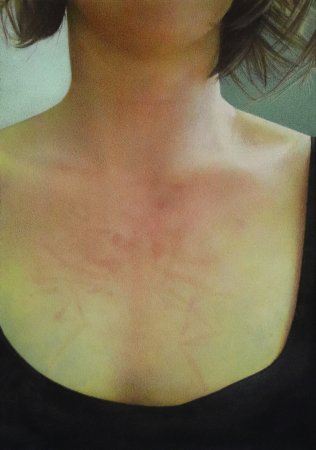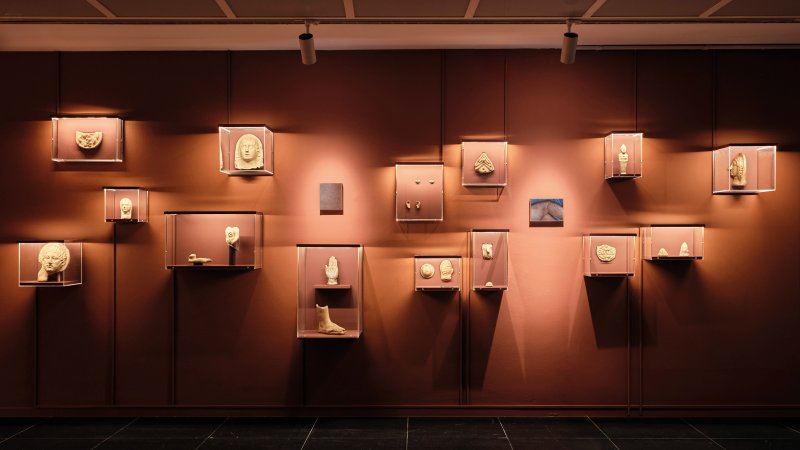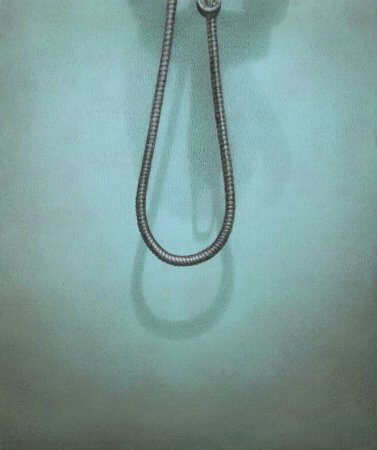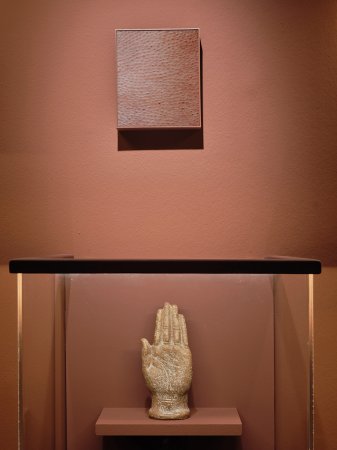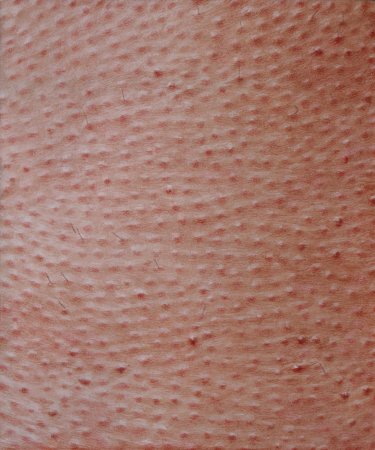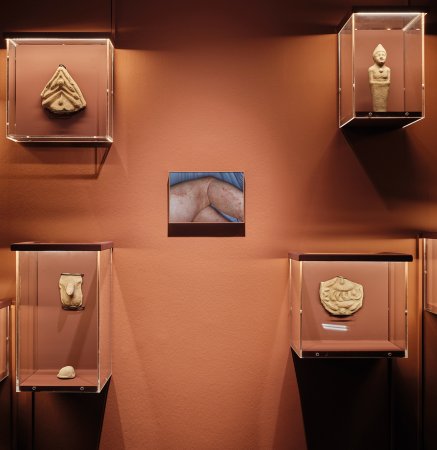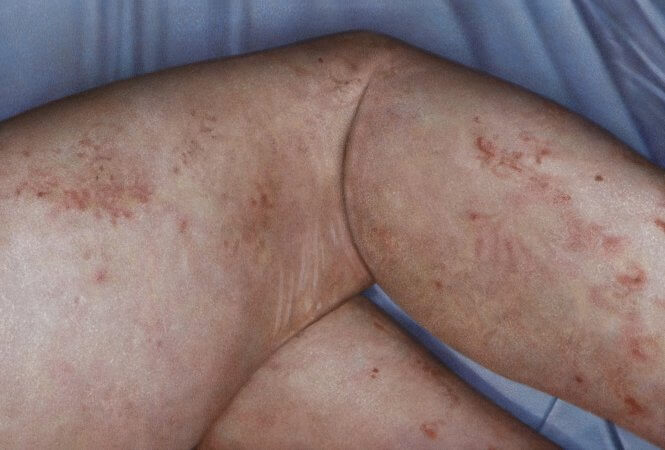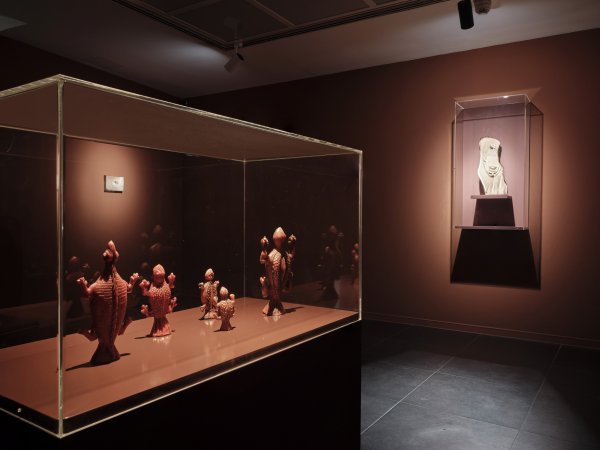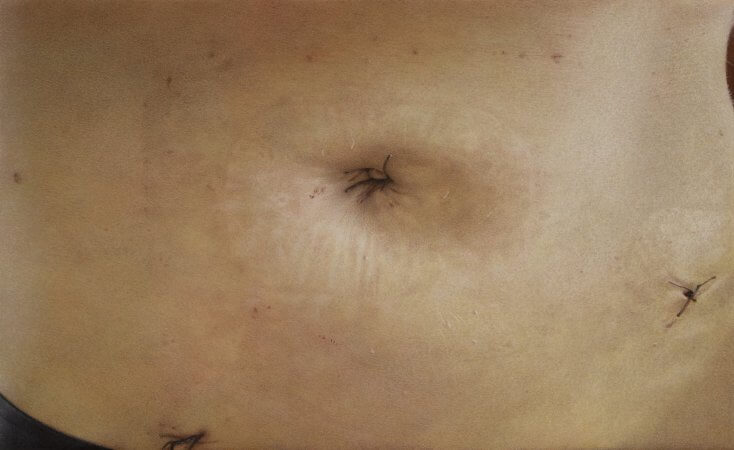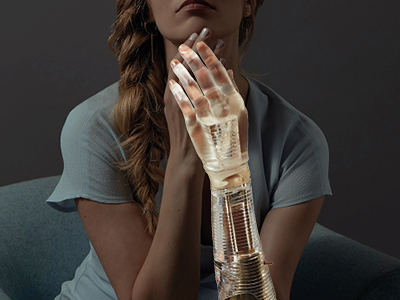Chiara Enzo
A me stessa (To myself), 2019
Tempera-Gouache, pastel, coloured pencils on cardboard, mounted on a wooden panel
16,8 x 24 cm, with frame 17,5 x 24,7 x 3,1 cm
Courtesy Private collection, Italy
Senza titolo (pelle) (Untitled, skin), 2019
Tempera-Gouache, pastel, coloured pencils on cardboard, mounted on a wooden panel
15 x 17,7 cm, with frame 15,8 x 18,6 x 3,1 cm
Courtesy MA COLLECTION Singapore
Visceri III (Addome operato) (Viscera III, operated abdomen), 2022
Watercolour, pastel, coloured pencils on cardboard, mounted on a wooden panel
24,3 x 15 cm, with frame 25 x 15,7 x 3,1 cm
Courtesy Collezione De Iorio, Italy
Senza titolo (doccia) (Untitled, shower), 2019
Tempera-Gouache, pastel, coloured pencils on cardboard, mounted on a wooden panel
17,7 x 15 cm, with frame 18,4 x 15,6 x 3,1 cm
Courtesy Private collection, Italy
Visceri IV (Gambe) (Viscera IV, legs), 2023
Watercolour, pastel, coloured pencils on cardboard, mounted on a wooden panel
22 x 15 cm, with frame 22,7 x 15,8 x 3,1 cm
Courtesy Private collection, Italy
Chiara Enzo’s work revolves around the notion of the boundaries between the self and the other. Where does the ‘I’ end and the ‘you’ begin? Do we merely have a body, or are we a body? Or perhaps both: are we the very body we possess? She poses questions about the universal experiences of being human—intimacy, vulnerability, fragility, illness—and how we construct an idea of reality out of perception.
Her central subject is the human body, the organism—in Greek organon, instrument—understood as a living tool of inquiry and as the site of perception. For her, the body becomes the interface of our being in the world—the mediating element through which our self relates to the world. Body, emotions and feelings are bound together in an inseparable interplay. Through the body we experience emotions. They generate biological and psychological responses, feelings through which we make sense of reality. We don’t have a body; we are our body, in the uniqueness of its constitution.
Chiara Enzo explains that her paintings arise from a sense of fragmentation. She experiences it as the impossibility to grasp the world in its entirety. Instead, she turns to the smallest units, to minimal, detailed experiences. Her paintings always show excerpts and partial views. She focuses on traces left by bodies, on absences or fragments of bodies that, in extreme close-up, appear disconcertingly private and intimate. This fragmentation reflects not only her own experience but also a contemporary condition: the perception of a world that reaches us in fragments through images and media. Her motifs are drawn from various visual contexts—from magazines, social media and personal photographs—out of which the artist has created an extensive archive.
In their fragmentary nature, her motifs don’t tell a grand, closed narrative but reveal the traces, the gaps, the unfinished. Many of her works revolve around images of intimate moments that are at the same time disseminated in the digital realm—social media as a private archive of intimacy. This ambivalent origin shifts perception: what appears personal and vulnerable is at once public and widely accessible. Even in an era of technologically supported medicine, the existential experience of human fragility remains fundamental and unalterable.
Chiara Enzo works rigorously and consistently in small formats, a practice that demands extreme precision and slowness. Yet it is not only the intimacy of the creative process—between the artist and the work—that interests her, but also the intimacy between the work and the viewer. The small scale and density of detail draw the viewer into physical proximity with the image. The gaze falls on the surfaces of the body, which are never intact or unscathed, bearing traces of injury, intervention, epidermal reactions or marks.
Enzo seeks an experience of connection between the subject, the work and the viewer. She paints surfaces that can be experienced not only visually but almost tactilely—as if the gaze itself were to become touch and the eyes could take on the function of hands. Within this field of tension, her work searches for a form of contact between image, body and perception.
Enzo’s artistic practice emerges from the act of drawing. She begins with coloured pencils and then moves into a process of painting in countless layers. She describes this practice as an attempt to reconstruct reality through the gesture of drawing. Through her gaze she feels her way into reality—probing it with her sense of sight—creating a relationship between the self and the other. Through the painting, the depiction of a body—in close proximity, laid bare—a feeling arises. Closeness is physical. Closeness is also an emotion, and it implies risk and vulnerability.
Since time immemorial, the act of drawing has been a visual process of thought. Through it, thoughts and emotions take shape in images, and decisions about how to depict a motif—form, framing, line, perspective and colour—create a reality of their own through art. For Chiara Enzo, seeing, observing and drawing are therefore not merely techniques, but a form of knowledge: a method of feeling one’s way into the world, of grasping it and forging a connection with it. For Enzo, drawing is a tool for giving meaning to reality—an approach to the real that we explore through our bodies.
Her working method is characterised by great slowness and persistence. The creation of a single image often requires months of work. Thus the works accompany the artist over a long period of time. With gouache, watercolour, chalk pastel and coloured pencils, she patiently draws lines on cardboard that, over time, condense into a richly detailed image. The dry, powdery quality of her materials allows her to deliberately extend the process.
In the exhibition Anatomy of Fragility, Chiara Enzo’s delicate works are suspended individually among the votive offerings of the Hans and Benedikt Hipp Collection and the Etruscan ex-votos of Justus Liebig University Giessen. Together, they testify to the primordial human experience of vulnerability and the desire for healing. Yet the manner in which this unfolds, and the significance attributed to the image of the body, differ profoundly. Votive offerings are imbued with a magical mode of thought in which a symbolic image, a surrogate fragment, is entrusted by a community with the power to perform a miracle on the corresponding part of the living body, in the immediacy of the present. By contrast, Chiara Enzo’s paintings address the question of what images of the body and its stagings express in an age of digital technologies and imaging techniques. Her works challenge the viewer’s ability to project an empathic imagination into her photorealistic depictions of the body in order to decode them, and to break with the heightened forms of self-representation.
A me stessa (To myself) shows a female portrait depicting the neck and neckline below the chin. The title reveals that it’s a self-portrait. Traditionally, self-portraiture in art has been a space of self-knowledge and self-presentation. Artists have not only recorded their outward appearance, but also used it as a means of questioning themselves. It is less concerned with resemblance than with an attempt to look beyond the mirror and to probe the depths of one’s own existence.
The face, and above all the gaze, have always been the primary bearers of identity—a projection screen of interiority and a means of making the self visible. Chiara Enzo breaks with this tradition by deliberately withholding her face. She shifts attention to the body, to those parts that usually stand at the margins of the image: chin, tips of hair, neck, a section of the sternum, etc. And she places these at the centre, marked by scratch-like traces, by skin reddened and rendered vulnerable. They speak of sensitivity, of bodily experience, without a specific event being named. The face remains hidden, identity anonymised. And yet her personal experience emerges.
With this, Enzo formulates a different understanding of the self-portrait: it is not the recognition of the individual that stands at the forefront, but the sensing of a bodily truth. The self is not told through the face, but through the trace, through the skin, through the marks of vulnerability.
Senza titolo (pelle) (Untitled, skin) shows a close-up of skin. The hair follicles are pronounced and the hairs stand upright—goosebumps. What is depicted here is an emotion, a bodily reaction—one that foregrounds the skin as an organ. A moment frozen in the image, in which the fleeting nature of sensation is transformed into an enduring imprint.
For Enzo, skin plays a central role in her understanding of being-in-the-world. It is both a boundary organ and contact surface—powerful and extremely sensitive. At once the site of pleasure and of pain. Through it we experience touch, vitality and connection to the world, and it is the threshold to the outside. At the same time, it is the most intimate organ one can reveal of oneself. Its imperfections make it particularly compelling: it ages, it scars, it bears traces. In it, the history of a person can be read; it preserves the marks of a lived life and speaks of a person’s past and transience.
In Visceri III (Viscera III), Chiara Enzo shows an operated abdomen. The detail focuses on the navel, where the imprint of a freshly removed plaster can be seen. Around it are the stitches and threads of surgery. Enzo directs the gaze to injured areas of skin—to traces, redness, scratches, scars. These are bodies stripped of any form of idealisation. So too in Visceri IV (Gambe) (Viscera IV, legs): instead of a flawless body, of immaculate skin, she opens an unfiltered view of the imperfection of the corporeal and of a deviation from the ideal as the very substance of art.
There are also pictorial spaces in Chiara Enzo’s work in which the body is absent, yet still palpable as a presence: depictions of surfaces and spaces that show no bodies, and yet are permeated by corporeality. The work Senza titolo (doccia) (Untitled, shower) presents an isolated view of a shower hose—both image and memory, atmospherically dense within the emptiness of a hospital washroom.
Chiara Enzo (*1989 Venice, IT) lives and works in Venice. Her practice moves between painting and drawing. In 2018, she graduated from the Academy of Fine Arts in Venice. In 2013, she studied for a year at De Montfort University in Leicester (UK). Enzo participated in the 59th Biennale di Venezia and is participating artist of this year‘s 18th Quadriennale di Roma. Her works were most recently exhibited at the following institutions: By Art Matters in Hangzhou (China); at the MACRO Museum in Rome (IT); at the Triennale Milano in Milan (IT); at Studio Neil Beloufa in Paris (FR), at Fondazione ICA in Milan (IT) and at Fondazione Bevilacqua La Masa in Venice (IT) as well as Galleria Zero in Milan (IT).

